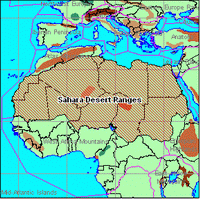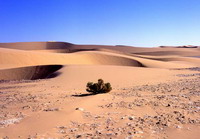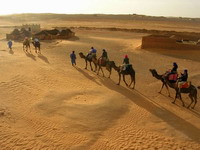Login form
Sahara Desert
 Sahara, great desert area, northern Africa, the western portion of the broad belt of arid land that extends from the Atlantic Ocean eastward past the Red Sea to Iraq.
Sahara, great desert area, northern Africa, the western portion of the broad belt of arid land that extends from the Atlantic Ocean eastward past the Red Sea to Iraq.
The entire desert, the largest in the world, is about 1,610 km (about 1,000 mi) wide and about 5,150 km (about 3,200 mi) long from east to west. The total area of the Sahara is more than 9.1 million sq km (more than 3.5 million sq mi), of which some 207,000 sq km (some 80,000 sq mi) consist of partially fertile oases.
The boundaries of the Sahara are the Atlantic Ocean on the west, the Atlas Mountains and the Mediterranean Sea on the north, the Red Sea and Egypt on the east, and the Sudan and the valley of the Niger River on the south. The boundaries, however, are not clearly defined and have been shifting for millennia. The Sahara was once a fertile area; millet was cultivated there over 8,000 years ago. As conditions gradually became drier, however, and desertification set in, farmers abandoned their land.
 Geographically distinct are the western Sahara, which is sometimes called the Sahara proper; the central Ahaggar Mountains and the Tibesti massif, a plateau region; and the Libyan Desert in the east. The western Sahara is an area of rock-strewn plains and sand deserts of varying elevation. The land is almost entirely without rainfall or surface water but possesses a number of underground rivers that flow from the Atlas and other mountains. Occasionally the waters of these rivers find their way to the surface; in these naturally irrigated oases, plants grow freely. The soil of this region of the Sahara is fertile and, where irrigation is possible, produces excellent crops. The central plateau region of the Sahara runs for approximately 1,610 km (approximately 1,000 mi) in a northwestern to southeastern direction. The plateau itself varies in height from about 580 to 760 m (about 1,900 to 2,500 ft), and peaks in the several mountain ranges that rise from the plateau are from about 1,830 to more than 3,414 m (about 6,000 to more than 11,200 ft) high. Notable peaks include Emi Koussi (3,415 m/ 11,204 ft), in the Tibesti massif, and Tahat (3,003 m/ 9,852 ft), in the Ahaggar range. Although rainfall is scanty in the area, a number of the central Saharan peaks are snowcapped during part of the year.
Geographically distinct are the western Sahara, which is sometimes called the Sahara proper; the central Ahaggar Mountains and the Tibesti massif, a plateau region; and the Libyan Desert in the east. The western Sahara is an area of rock-strewn plains and sand deserts of varying elevation. The land is almost entirely without rainfall or surface water but possesses a number of underground rivers that flow from the Atlas and other mountains. Occasionally the waters of these rivers find their way to the surface; in these naturally irrigated oases, plants grow freely. The soil of this region of the Sahara is fertile and, where irrigation is possible, produces excellent crops. The central plateau region of the Sahara runs for approximately 1,610 km (approximately 1,000 mi) in a northwestern to southeastern direction. The plateau itself varies in height from about 580 to 760 m (about 1,900 to 2,500 ft), and peaks in the several mountain ranges that rise from the plateau are from about 1,830 to more than 3,414 m (about 6,000 to more than 11,200 ft) high. Notable peaks include Emi Koussi (3,415 m/ 11,204 ft), in the Tibesti massif, and Tahat (3,003 m/ 9,852 ft), in the Ahaggar range. Although rainfall is scanty in the area, a number of the central Saharan peaks are snowcapped during part of the year.
The Libyan Desert is considered the most arid part of the Sahara. Moisture is almost totally absent and few oases exist. The land is characterized by sandy wastes and large dunes of sand 122 m (400 ft) or more in height. The valley of the Nile River and the mountainous area of the Nubian Desert to the east of the Nile are, geographically, part of the Sahara, but the irrigation afforded by the Nile transforms the desert into fertile agricultural land throughout much of Egypt.

Politically, the Sahara lies largely in Morocco, Algeria, Tunisia, Libya, Egypt, Mauritania, Mali, Niger, Chad, and Sudan.

